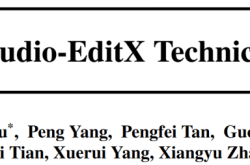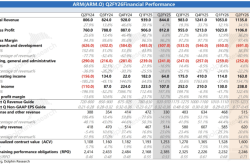MediaTek's 2024: Steady Mid-Range Growth, High-End Ambition, and AI Breakthroughs
![]() 12/30 2024
12/30 2024
![]() 476
476
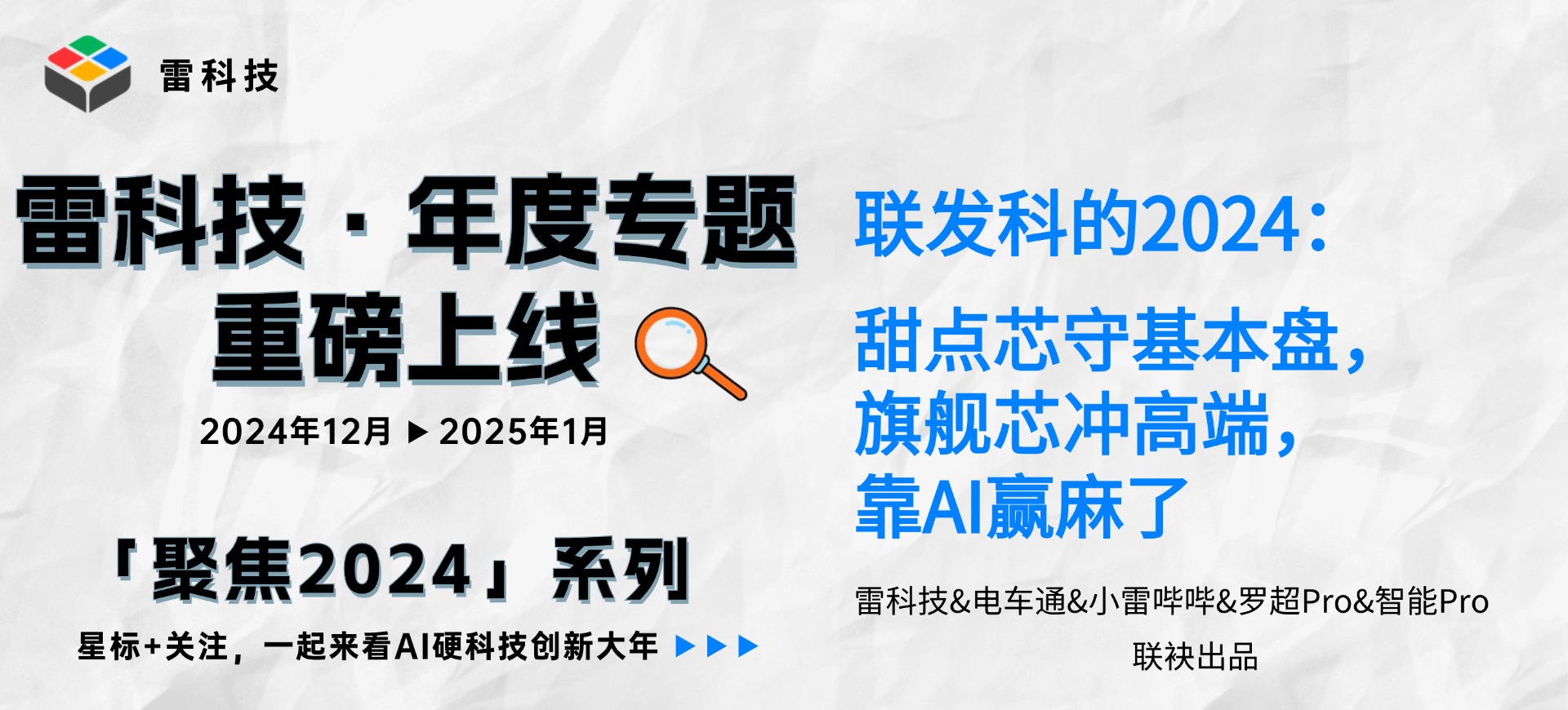
2024 marked a pivotal year for AI hardware innovation.
"Not competing on specs, but on applications" has emerged as a unifying principle in the AI industry. On one hand, AI features are deeply integrated into hardware, fueling an explosion of AI-enabled devices across sectors like mobile phones, PCs, home appliances, automobiles, cleaning products, home furnishings, headphones, cameras, and storage solutions. On the other hand, AI is profoundly transforming software, with native AI applications like Wenxiaoyan and Doubao gaining traction, while search engines, input methods, browsers, payment systems, office software, and e-commerce platforms are being reshaped by AI.
AI has become the "magic wand" of technological innovation, and this is merely the beginning.
In December, we launched the "Leitech Annual" special issue, featuring "Focus on 2024" which systematically reviews notable companies, products, technologies, and individuals in the tech industry this year, and "Looking Ahead to 2025" which previews anticipated products and technologies for the coming year, paying tribute to innovation, chronicling the times, and inspiring the future.
Please subscribe and stay tuned.
2024 was a year of full recovery for the mobile phone market, with increased overall shipments boosting manufacturers' confidence. New mobile phones continually evolved in design, imaging, screens, and other aspects, infusing new energy into an increasingly competitive market.
As one of the leading mobile chip suppliers, MediaTek also brought us numerous surprises this year. Through rapid product iteration, MediaTek accelerated its market share, engaging in fierce competition with Qualcomm. As the year draws to a close, let's reflect on the impressive products MediaTek introduced as part of Leitech's 2024 annual special issue.
Re-entering the High-End Market: The Ascent of Dimensity Flagship Chips
In 2021, MediaTek unveiled its first flagship mobile chip, the Dimensity 9000, whose specifications and performance finally equipped MediaTek with the prowess to compete in the high-end market. Subsequently, MediaTek released multiple high-end chips, gradually gaining market acceptance for its high-end positioning.
In 2024, MediaTek's two flagship chips, the Dimensity 9300+ and Dimensity 9400, further redefined the market's perception of MediaTek.

(Image source: MediaTek official)
Let's start with the Dimensity 9300+, released in May this year. It adopted an all-big-core CPU architecture with a frequency boost to 3.4GHz, theoretically outperforming Apple's A16 processor, showcasing MediaTek's immense potential.
However, due to its awkward release timing, few models were equipped with the Dimensity 9300+ this year, and most were mid-range products. The only true flagships were the vivo X100s and X100s Pro. Although the number of models equipped with it was not substantial, the fact that domestic manufacturers were eager to compete for the first launch of Dimensity chips indicates that MediaTek has gained a significant influence in the high-end market.
MediaTek's real trump card this year was the Dimensity 9400, released in November. It continued the all-big-core design and adopted a second-generation 3nm process, significantly reducing power consumption.

(Image source: MediaTek official)
According to MediaTek, the Dimensity 9400 offers a 41% peak performance improvement over the Dimensity 9300 while reducing power consumption by 44%, an unprecedented achievement. Leitech also conducted detailed performance tests on several models equipped with the Dimensity 9400. Taking the vivo X200, the first to launch with the Dimensity 9400, as an example, it not only maintained full frame rates in a series of 3A mobile games but also had an average power consumption of never exceeding 5W, truly making it a new generation of flagship powerhouse.
Moreover, the Dimensity 9400 includes PC-level hardware-based ray tracing, a faster and smoother Dimensity StarSpeed Engine, and a series of AI features, visibly enhancing the gaming experience.
In terms of AI, the Dimensity 9400 also exhibits significant improvements. In the AI-Benchmark rankings, its AI score exceeds 10,000 points, nearly a 50% increase compared to the Dimensity 9300 and Dimensity 9300+. This outstanding AI capability can further unleash the potential of AI on mobile devices and drive the creation of more innovative generative AI applications.

(Image source: MediaTek official)
The release of the Dimensity 9400 also conveys a new message to the market: blindly pursuing high frequencies is not beneficial. It is more meaningful to use new architectures, processes, and AI technologies to enhance the daily user experience of processors.
If the Dimensity 9300 released last year was MediaTek's first strike at the high-end market, then the all-around evolution of the Dimensity 9400 this year proves that MediaTek chips can also become a standard for flagship mobile phones. However, for MediaTek to firmly establish itself in the high-end chip market, it needs not only to showcase impressive technical specifications but also to build up its ecosystem capabilities and strengthen partnerships, which will take time.
"Three Sweet Spot Chips" Stabilizing the Mid-Range and Low-End Base
High-end mobile phones are mere showcases for manufacturers, with sales primarily coming from mid-range and low-end devices. In other words, to increase their market share, both mobile phone manufacturers and chip manufacturers must offer genuinely compelling products in the mid-range and low-end markets.
MediaTek's answer is the Dimensity 8250, Dimensity 8350, and Dimensity 8400.
The Dimensity 8250 can be considered a "rebranded" chip, with its hardware architecture identical to the Dimensity 8200 released in 2022, except for the addition of a new technology called StarSpeed Engine, which MediaTek claims enhances gaming performance. However, considering that only the OPPO Reno 12 is currently equipped with the Dimensity 8250, we won't delve into it further here.
The focus is on the Dimensity 8350 and Dimensity 8400.
The Dimensity 8350 made its debut on the OPPO Reno 13/Pro. Despite its seemingly modest naming and positioning, it underwent a qualitative upgrade in architecture and frequency compared to last year's Dimensity 8300, with CPU and GPU performance close to that of the Dimensity 9200 processor, making it stand out in the mid-range.
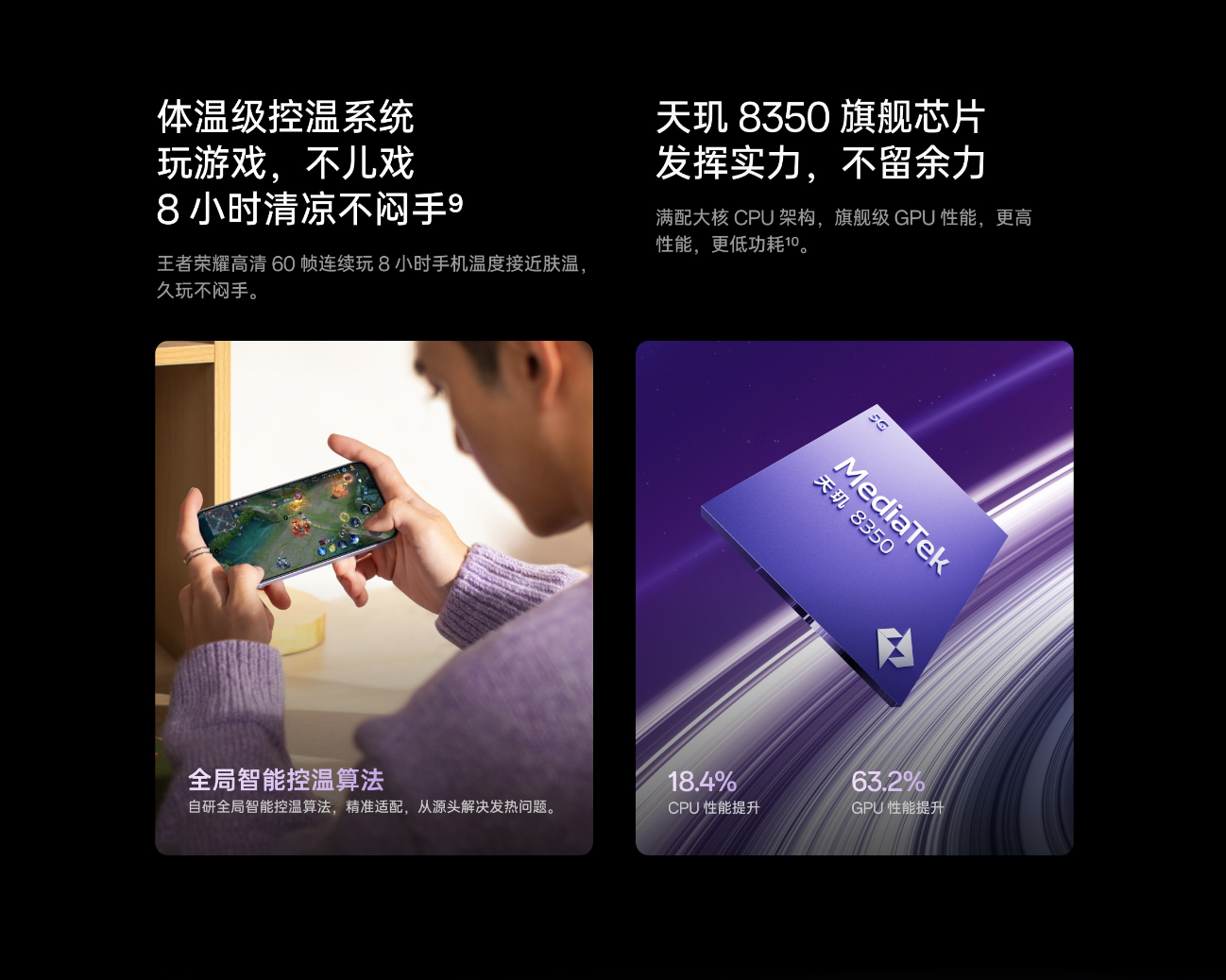
(Image source: OPPO official)
The Dimensity 8400 not only achieves qualitative improvements in performance and power consumption compared to its predecessor but also approaches the Dimensity 9300 in overall performance. It also introduces several flagship-level features typically not found in mid-range processors: MediaTek Imagiq 1080 ISP image processor, 5G-A modem, and network quality monitoring system.
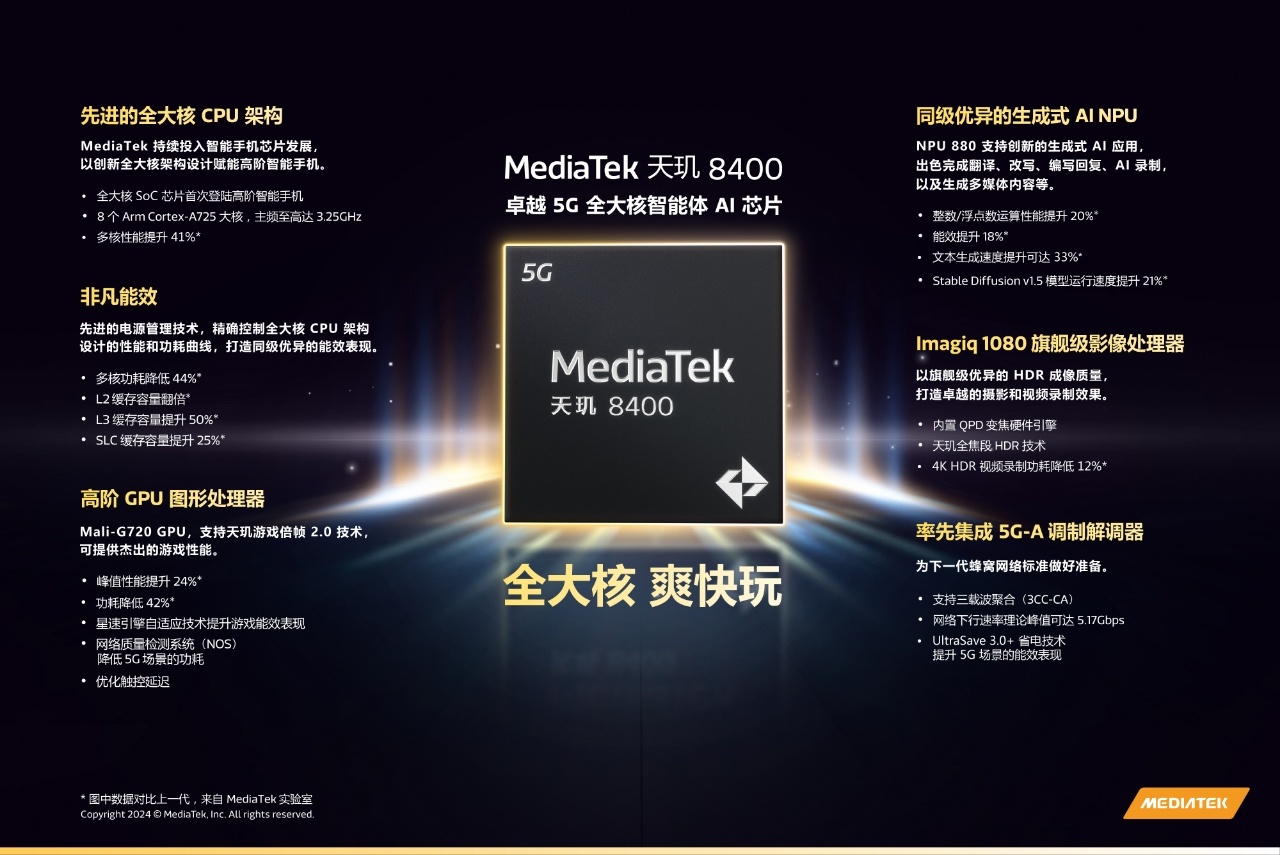
(Image source: MediaTek official)
Today, MediaTek's 8-series processors not only offer performance comparable to that of secondary flagship devices but also support flagship-level AI capabilities and image processing, perfectly catering to the mid-range mobile phone market and enabling users with limited budgets but certain expectations to purchase satisfactory products.
This year, MediaTek not only launched products in the high-end and mid-range markets but also provided an exceptional experience across the board. If MediaTek continues this momentum in 2025, its competitors will face significant pressure. In fact, the mid-range and low-end markets remain MediaTek's core base in the mobile phone market. According to Canalys data, MediaTek maintained its top position with a 38% market share in the third quarter of 2024, marking the 15th consecutive quarter as the leader.
In Leitech's view, MediaTek's long-term dominance in the mobile chip market share is attributed to its strong performance in mid-range and low-end chips. For these markets, MediaTek has created a plethora of "sweet spot" chip products that meet users' mainstream needs with relatively good performance and peripheral configurations. Moreover, Dimensity chips still have a significant price advantage in this segment, which explains their popularity among mobile phone manufacturers.
Comprehensive AI Focus: MediaTek Wins at the Starting Line
Today's mobile chips are not limited to CPUs and GPUs but also integrate AI computing units, ISP image processors, communication chips, baseband chips, and more. In other words, to gain consumer recognition, chip manufacturers must collaborate with mobile phone manufacturers to provide solutions tailored to users' different usage scenarios, not just relying on strong mobile gaming performance.
One noteworthy aspect is AI. Long before the AI concept became popular, MediaTek had already made layouts, with independent AI computing units found in almost every MediaTek chip. For example, the Dimensity 9400 is equipped with the NPU 890, the first NPU on the market to support on-device LoRA training and high-quality video generation. Compared to the Dimensity 9300, it offers an 80% improvement in prompt processing performance for large language models (LLMs) and a 35% reduction in power consumption.

(Image source: MediaTek official)
The Dimensity 9400 also integrates the MediaTek Dimensity Agentic AI Engine, which can upgrade traditional AI applications to more advanced intelligent AI applications. MediaTek actively collaborates with developers to provide a unified standard interface for future AI agents, third-party applications, and large models, reducing development difficulty and accelerating the construction of the AI ecosystem.
MediaTek's efforts in AI have also indirectly accelerated the evolution of on-device AI. Today, we can generate images and videos on our phones, process image documents with AI, and even ask AI to summarize long and tedious academic papers. All this is made possible by MediaTek's dedication to AI.
A close examination of MediaTek's processors this year reveals a common theme: focusing on energy efficiency, which lays a solid foundation for MediaTek to drive AI development. Some readers may wonder how processor energy efficiency is related to AI. In fact, AI significantly impacts device power consumption. Without basic battery life assurance, even the strongest and most user-friendly AI features will only hinder mobile performance.
Beyond mobile chips, MediaTek has also achieved notable results in AI-based networking and PC chips. Leveraging the powerful AI performance of Dimensity processors, MediaTek introduced a technology called Gen-AI compute as One. In February 2024, Leitech's MWC 2024 reporting team provided a special report on this technology. Simply put, with this technology, installing a distributed access point at home or in the office allows all devices connected to the same Wi-Fi to share their computing power.
According to MediaTek, originally, the entire rendering task would be handled by a laptop. However, when a phone next to the laptop is connected to the Wi-Fi, 30% of the rendering task on the computer is automatically assigned to the phone. Adding another phone reduces the computer's "workload" by another 30%.

(Image source: Leitech production)
This technology keeps all devices in the area active rather than concentrating all tasks on a single smart terminal, increasing task processing speed and indirectly reducing user costs. Previously, high-performance laptops were required for certain tasks, but now, these tasks can be efficiently completed using a lightweight laptop and smartphone.
Besides conventional CPUs, NPUs, and GPUs, this technology can even automatically integrate the AI computing power of all devices in the area, enabling a smartphone to possess AI computing power comparable to a PC. Although this technology is not fully implemented yet, it is foreseeable that in the future AI era, MediaTek's solution and approach will undoubtedly be studied and emulated by many manufacturers.
From MediaTek's investment and development priorities in chip technology, it is evident that MediaTek's ambition extends beyond being just a chip supplier. It aims to build its AI computing ecosystem through chips, helping software and hardware developers create more new features that address user pain points. As MediaTek's ecosystem matures, Dimensity chips will become more competitive. For MediaTek, this ecosystem will also help solidify its "moat" and further expand the experience advantages of Dimensity products.
Source: Leitech

